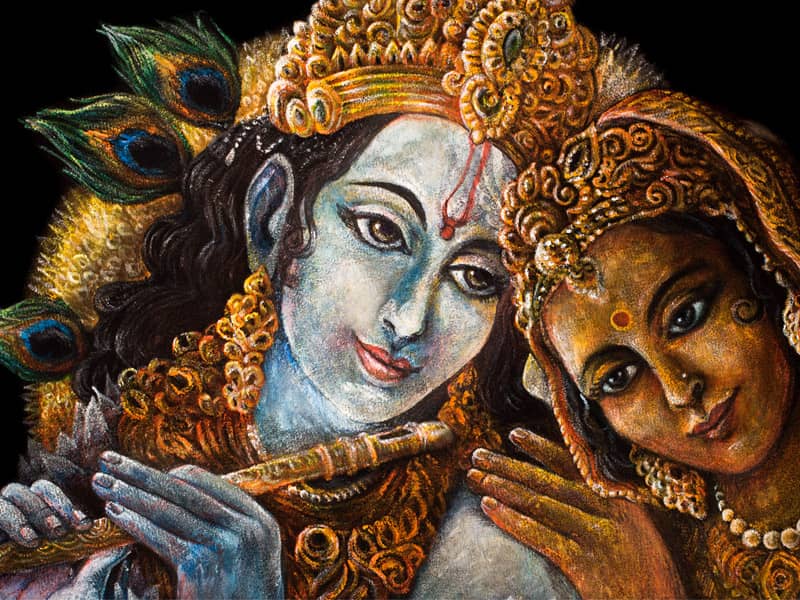Visit the museum's online store and you'll find, sandwiched between a glass panel of Gustav Klimt's "The Kiss" ($40) and a Cupid and Psyche T-shirt (now just $10), a white canvas tote bag featuring Krishna and his partner in love, Radha. That for the low price of just $24.
And if that's not declaration enough for your significant other, you could opt for the couple's image silk-screened onto a saffron-colored T-shirt. Goodness only knows how an ancient Hindu god became a poster boy for a Western consumerist bonanza, but then again, the Philly Museum might be on to something. After all, even as a young cowherd, Krishna's dark, handsome features, luminous eyes and flute-playing abilities were legendary, moving the gopis, or milk maidens, of his village to ecstasy.
Outwardly, of course, many of the gopis resented Krishna. He was always stealing their clothes while they bathed in the river, and whenever one of them walked by, clay pot overflowing with butter or milk, Krishna would invariably toss a well-aimed stone in her direction, shattering the pot.
Perhaps this seems at first glance like classic bad-boy behavior. But for the devotee of Krishna, one of many earthly manifestations of a universal god, it is something altogether richer and more profound. "God appears on this earth to display his opulence and attract the souls lost in this material world to come back to him," said Anuttama Dasa, national communications director of ISKCON, popularly known as the Hare Krishnas. "Because he is God, even his naughty behavior is all-attractive."
As the story goes, Krishna was the ultimate romantic partner, skilled in the 64 arts of love. During the famous ras-lila, his divine dance with the gopis, he multiplied in form, thousands of times, so that each gopi would have God to herself. Therein lies the paradox: God as simultaneously playful (one might say a playboy) and as infinitely committed to each devotee. "According to the Indian scripture of dance, the Natya Shastra, there are four types of heroes," said Francis Barboza, a New Jersey-based dancer who has regularly portrayed Krishna in his performances. "Dheeralilita--playful and overactive--suits the characteristic of Krishna. Here the external activities of love are over-emphasized. He is at times compared to a honey-bee which jumps from one flower to the other."
But for the modern man who thinks of emulating the amorous ways of the lord, a quick caveat: You're no Krishna. "Because Krishna is God himself, we cannot think of imitating him," said Chith Puram, an engineer in Houston who is a devotee of Krishna. "However, we can try to do things he prescribed."
And that, devotees say, would be to acknowledge desire in all spheres of life, but to channel it toward the divine. "We believe desire can't be stopped," said Dasa. "Spiritual life means to purify desire by directing it toward God. We all desire to hear beautiful music, but recommend listening to music that glorifies God. We want tasty food, so we cook nice vegetarian meals in a devotional mood, offer that to God, and enjoy his gifts. Real happiness comes from developing our love for God, and offering all that we do for his satisfaction."
This approach, known as bhakti, or personal devotion to God, was oddly enough born on the battlefield. It was at the onset of war that Krishna, now a chariot driver, recited the Bhagavad Gita, or Song of God, to his cousin Arjuna, a prince overwhelmed by doubt. Krishna informs Arjuna that God is not an elusive goal, meant only for philosophers and mystics, but something very real and attainable, here and now.
For many Hindus, Krishna's amorous exploits make him very real and tangible, but at the same time point to something more lasting and permanent. "We believe this is one reason Krishna appears on earth and displays his beauty, his transcendental pastimes," said Dasa. "We all seek `true love,' one that will last `forever' and to find someone who will `be mine.' Valentine's Day is a celebration of that need of the heart."

